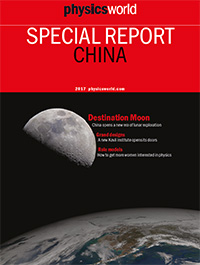By Michael Banks
The pace of change in China can be bewildering – and science is no exception. With every year that goes by, the country publishes more papers, spends more cash on research and opens up yet more world-class facilities.
 This is the third Physics World special report on physics in China – following publications last year and in 2011.
This is the third Physics World special report on physics in China – following publications last year and in 2011.
Most of this year’s report was based on an action-packed schedule of visits and interviews earlier this year at institutes and labs in Shanghai and Beijing.
Speaking to researchers during my travels, it became clear that China is reaping particular benefits from its 1000 Talents programme, which seeks to persuade top Chinese researchers who have spent time abroad to return home. Such scientists are bringing huge experience back and using it to put China at the forefront of many fields of research.
China is also showing a growing appetite to attract foreign scientists who have not worked there before. Getting overseas researchers to move to China is not always easy, so one solution has been for China to encourage Western institutions to branch out into the country. The Kavli Foundation, for example, has just opened a new Kavli Institute for Theoretical Sciences in Beijing, which aims to have about a third of its faculty from outside China.
New York University, meanwhile, has teamed up with the East China Normal University in Shanghai to create NYU Shanghai, which is largely independent of its parent organization and offers its own degrees. The physics department is small but growing and again targeting a mix of Chinese and foreign researchers.
For all the shiny new facilities and great research, there is still room for improvement in Chinese physics. During my recent trip, I visited more than 10 institutions and met at least 50 researchers, yet just two were women. Yes, there are valiant attempts to get more women into physics, but more needs to be done.
Here is a run-down of what’s in the issue:
China targets lunar missions – China is quickly becoming a global leader in lunar exploration
Building bridges with the West – Fuchun Zhang, from the Kavli Institute of Theoretical Sciences, discusses the challenges of attracting top-class talent to China
A new approach – how the physics department at the first US–Sino university is set to expand
Widening horizons – Xinzheng Li from Peking University explains why it is important for early-career scientists in China to gain research experience outside of the country
The power of role models – Ling-An Wu from the Institute of Physics, Chinese Academy of Sciences, describes a lecture-tour series for students studying physics in remote areas
I hope you find this special report interesting, and if you’d like to share your thoughts on it, please get in touch by e-mailing us at pwld@iop.org.
Guidelines
Show/hide formatting guidelines
this text was deletedwhere people live in harmony with nature and animals</q>
Some text